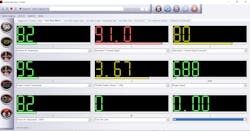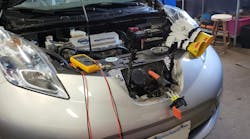Vehicle affected - All
Tools used
· Vehicle Repair Information
· DMM
· Battery Charger
· Charging System Analyzer
· Scan Tool
This article is a follow-up to the October 2018 PTEN issue regarding new battery technologies and how to test them. Advances in battery technology forced changes in both vehicle charging systems and the diagnostic test procedures required to make sure the system is functioning properly.
The role of the charging system, which is to maintain the correct voltage of the battery as it is used to power various items, such as starters, lamps, and all the other electronic systems, has remained consistent ever since they were first placed on vehicles. What has changed is how charging systems maintain the level of charge in order to keep all of the electronics functioning, while at the same time reducing the load on the engine to meet mandated fuel economy standards.
Because of these shifts in the technology, when a charging system is malfunctioning you will need to update both your diagnostic process, and most likely, the tools that are required for an accurate diagnosis. As with arguably almost any repair on today’s vehicles, the most important tool is having the correct and relevant information readily available – not only the specific vehicle information necessary for performing diagnostic tests, but other information such as wiring diagrams and alternator output specifications, which are not the same for every vehicle and not the same across all of a vehicle manufacturer’s cars in any given year.
Basically, the old rule of thumb that a charging system was functioning properly if it could produce around 14.5 volts is no longer applicable. In many vehicles, the charging system will charge the system at a high rate initially after starting, then reduce the charge rate to around 13.0 volts (float voltage) in order to reduce engine load, thereby improving fuel economy. The charge rate is initially high in order to return the battery to its full state of charge quickly. Charge rates and float voltage values can change in either high or low ambient temperatures in order to prevent over or undercharging batteries.
Here are the steps you can take to perform a complete charging system diagnosis:
Step 1 – Obtain specific vehicle information
Check for any relevant technical service bulletins (TSBs) – if there are none, before you even think about testing a charging system, you need to understand what steps should to be taken in order to ready the vehicle for testing the system. This may seem unnecessary, but since battery technologies have evolved and vehicle manufacturers have incorporated these new designs into their vehicles, understanding what type of battery was originally installed in the vehicle and assuring that the same type of battery is currently in place is extremely important.
Just as important, is making sure the vehicle is prepared and in the correct condition, meaning the engine operating temperature is at the specification listed and all accessories are either on or off as dictated by the OE’s test parameters.
Every vehicle is built with different options. Many of these options have different electrical load demands. Obtaining specific charging system specifications is a critical step, along with obtaining alternator output specifications. This gives you is a clear understanding of what steps you need to take and what tools are required to test alternator output. For example, some vehicles will require you to use a voltmeter and amp clamp to monitor output voltage while turning on various loads like A/C and lamps, others will require you to use your scan tool to activate the field of the alternator in order to get maximum output, and still others use a combination of a meter and a carbon pile load tool.
Step 2 – Test the battery and connections
One of the most crucial steps is to make sure the battery is fully charged. This step requires an understanding of the type of battery and having the correct charger and test equipment to make sure the battery is charged and passes the test. Starting with a fully charged battery is also important because many computer-controlled charging systems adjust charge rates based on the batteries’ state of health and state of charge. Be sure to use the correct battery charger, set to the proper settings, to charge and test the battery. Some of the newer chargers/analyzers on the market such as Associated Equipment’s Intellamatic series chargers are able to test and charge any battery.
The next thing to do is to make sure that all of the battery connections are clean and tight. There is no substitute for a visual inspection for this, but because many vehicles have their batteries mounted remotely and have test points that are easily accessible, many technicians skip this essential step. A quick way to check connections on remote systems is to use a borescope camera to get a visual image of the condition of the battery terminals and look for any signs of corrosion that will cause excess resistance in the circuit. Another relatively easy way to check for resistance is to use your DMM to perform a voltage drop test on both the positive and ground sides of the circuit, meaning you would be testing the output terminal of the alternator and the case ground.
Another aspect that is commonly overlooked is the condition of the drive belt and tensioner. The alternator relies on RPM in order to create enough amperage to meet its demand; any slipping of the belt due to worn out grooves, or a tensioner that is allowing the belt to slip at higher engine speeds, will affect its output. Even if the belt looks good, use a tool such as the Gates Belt Wear Gauge to assure the belt is not worn to the point of slipping.
A common failure point with charging systems is high resistance at the connector(s) on the alternator. This resistance can either be caused by corrosion, mainly due to moisture entering the connector, or by excess heat melting terminals, typically caused by a loose connection. In either case, the best repair is to replace the connectors instead of attempting to repair them.
Step 3 – Use a charging system analyzer
There are quite a few charging system analyzers on the market. Some testers use algorithms to look for voltage or amperage anomalies that would indicate a fault in the system. Others use a carbon pile to create a load which requires the charging system to increase output to meet the higher demand. Many of the analyzers are relatively low-cost handheld units, some with printers, others without. If the vehicle you are working on requires a test using a carbon pile, you will most likely not be able to find a handheld unit that can create enough load to satisfy the test requirements of that vehicle manufacturer. Almost all testers use a ripple test to monitor the charging system for AC voltage above .5 volts. The presence of higher than .5 VAC indicates a faulty alternator.
Step 4 – Use your scan tool
In order to understand some of the PIDS that are relevant to the charging system, access your vehicle information database and review the component operation section. This will provide you with an overview of which components the PCM uses to maintain and regulate the charging system output. Common PIDS the PCM will monitor are:
· Intake Air Temperature: used to adjust charging output to meet ambient air conditions
· Fuel grams per second: used to adjust output if the fuel pump is running at a high rate
· Throttle Position: used to adjust the output for engine speed
· Cooling fan speed: used to adjust the output for greater load when fans are on
· Engine Coolant Sensor: used to adjust the output for changing engine temperatures
Once you have this information, scan the system for codes. Pay particular attention to any “U” codes. These codes mean there is a lack of communication between modules in the CAN bus and should always be addressed first. Next, look for any codes in the PIDS the PCM uses to adjust charging system output as these can affect the charging system’s operation.
Next look to see if there are any codes in the charging system itself. Most vehicles now monitor the charging system and are very good about setting codes when there is an issue. It also is a good idea to check the BCM for any codes just to make sure none of your high electrical demand components, such as rear window defrosters, have any problems.
Once the codes have been checked and addressed, connect an amp clamp to the battery, then use your scan tool to command the charging system to charge at its maximum rate while monitoring the voltage and amperage. The output voltage and amperage must be within the specifications listed in your information database. If there are no codes present, your scan tool is commanding the system to charge at its maximum rate and the PCM is seeing the command to charge, that the wiring connections are good and that the belt is not slipping, meaning most likely the alternator is at fault. Remember there are exceptions to every rule…
Case Study: 2012 Honda Accord, intermittent charging system failure
This vehicle came in with an intermittent issue where the charging system would have low output and the headlamps would flicker. When we got the vehicle there were no codes present and the system was functioning properly following all of the test protocols outlined by Mitchell 1. Looking further into the system description, Honda uses an Electronic Load Detector (ELD). The ELD is a relay type of device located in the underhood relay/fuse center. The ELD is used to send a signal based on voltage demand to the PCM, where the PCM then turns on or off the charging system to meet the demand.
At this time, there were no issues with the charging system, and there were no TSBs listed for this issue. One of my technicians previously worked at a Honda dealership, and he remembered hearing about loose solder joints in the ELD that would cause a similar issue. Armed with this knowledge, we lightly tapped on the ELD while we monitored the signal to the PCM with our scan tool. Sure enough, every time we tapped on the ELD, the signal voltage would go to around 4.0 volts, meaning demand was low and the system did not require a high output from the alternator.
We replaced the ELD and retested the system and had no further issues. Once again, proven test methods, combined with the right information and tools, resulted in a correct repair. In this case, we were lucky to have a technician that had heard about a similar intermittent issue which saved us a lot of time.


